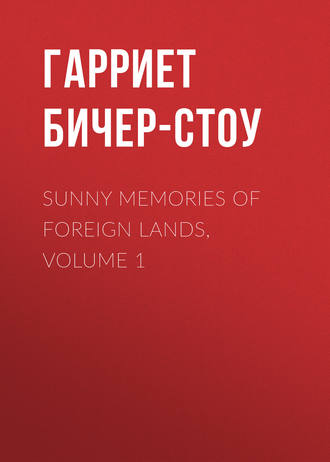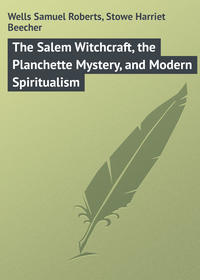 полная версия
полная версияSunny Memories Of Foreign Lands, Volume 1
A little farther along towards Aberdeen, Mr. S. seemed to amuse himself very much with the idea, that we were coming near to Dugald Dalgetty's estate of Drumthwacket, an historical remembrance which I take to be somewhat apocryphal.
It was towards the close of the afternoon that we found ourselves crossing the Dee, in view of Aberdeen. My spirits were wonderfully elated: the grand sea scenery and fine bracing air; the noble, distant view of the city, rising with its harbor and shipping, all filled me with delight. Besides which the Dee had been enchanted for me from my childhood, by a wild old ballad which I used to hear sung to a Scottish tune, equally wild and pathetic. I repeated it to C–, and will now to you.
"The moon had climbed the highest hillThat rises o'er the banks of Dee,And from her farthest summit pouredHer silver light o'er tower and tree,—When Mary laid her down to sleep,Her thoughts on Sandy far at sea,And soft and low a voice she heard,Saying, 'Mary, weep no more for me.'She from her pillow gently raisedHer head, to see who there might be;She saw young Sandy shivering stand,With pallid cheek and hollow ee.'O Mary dear, cold is my clay;It lies beneath the stormy sea;The storm, is past, and I'm at rest;So, Mary, weep no more for me.'Loud crew the cock; the vision fled;No more young Sandy could she see;But soft a parting whisper said,'Sweet Mary, weep no more for me.'"I never saw these lines in print any where; I never knew who wrote them; I had only heard them sung at the fireside when a child, to a tune as dreamy and sweet as themselves; but they rose upon me like an enchantment, as I crossed the Dee, in view of that very German Ocean, famed for its storms and shipwrecks.
In this propitious state, disposed to be pleased with every thing, our hearts responded warmly to the greetings of the many friends who were waiting for us at the station house.
The lord provost received us into his carriage, and as we drove along, pointed out to us the various objects of interest in the beautiful town. Among other things, a fine old bridge across the Dee attracted our particular attention.
We were conducted to the house of Mr. Cruikshank, a Friend, and found waiting for us there the thoughtful hospitality which we had ever experienced in all our stopping-places. A snug little quiet supper was laid out upon the table, of which we partook in haste, as we were informed that the assembly at the hall were waiting to receive us.
There arrived, we found the hall crowded, and with difficulty made our way to the platform. Whether owing to the stimulating effect of the air from the ocean, or to the comparatively social aspect of the scene, or perhaps to both, certain it is, that we enjoyed the meeting with great zest. I was surrounded on the stage with blooming young ladies, one of whom put into my hands a beautiful bouquet, some flowers of which I have now dried in my album. The refreshment tables were adorned with some exquisite wax flowers, the work, as I was afterwards told, of a young lady in the place. One of the designs especially interested me. It was a group of water lilies resting on a mirror, which gave them the appearance of growing in the water.
We had some very animated speaking, in which the speakers contrived to blend enthusiastic admiration and love for America with detestation of slavery.
All the afternoon the beautiful coast had reminded me of the State of Maine, and the genius of the meeting confirmed the association. They seemed to me to be a plain, genial, strong, warm-hearted people, like those of Maine.
One of the speakers concluded his address by saying that John Bull and Brother Jonathan, with Paddy and Sandy Scott, should they clasp hands together, might stand against the world; which sentiment was responded to with thunders of applause.
It is because America, like Scotland, has stood for right against oppression, that the Scotch love and sympathize with her. For this reason do they feel it as something taken from the strength of a common cause, when America sides with injustice and oppression. The children of the Covenant and the children of the Puritans are of one blood.
They presented an offering in a beautiful embroidered purse, and after much shaking of hands we went home, and sat down to the supper table, for a little more chat, before going to bed. The next morning,—as we had only till noon to stay in Aberdeen,—our friends, the lord provost, and Mr. Leslie, the architect, came immediately after breakfast to show us the place.
The town of Aberdeen is a very fine one, and owes much of its beauty to the light-colored granite of which most of the houses are built. It has broad, clean, beautiful streets, and many very curious and interesting public buildings. The town exhibits that union of the hoary past with the bustling present which is characteristic of the old world.
It has two parts, the old and the new, as unlike as L'Allegro and Penseroso—the new, clean, and modern; the old, mossy and dreamy. The old town is called Alton, and has venerable houses, standing, many of them, in ancient gardens. And here rises the peculiar, old, gray cathedral. These Scotch cathedrals have a sort of stubbed appearance, and look like the expression in stone of defiant, invincible resolution. This is of primitive granite, in the same heavy, massive style as the cathedral of Glasgow, but having strong individualities of its own.
Whoever located the ecclesiastical buildings of England and Scotland certainly had an exquisite perception of natural scenery; for one notices that they are almost invariably placed on just that point of the landscape, where the poet or the artist would say they should be. These cathedrals, though all having a general similarity of design, seem, each one, to have its own personality, as much as a human being. Looking at nineteen of them is no compensation to you for omitting the twentieth; there will certainly be something new and peculiar in that.
This Aberdeen Cathedral, or Cathedral of St. Machar, is situated on the banks of the River Don; one of those beautiful amber-brown rivers that color the stones and pebbles at the bottom with a yellow light, such as one sees in ancient pictures. Old trees wave and rustle around, and the building itself, though a part of it has fallen into ruins, has, in many parts, a wonderful clearness and sharpness of outline. I cannot describe these things to you; architectural terms convey no picture to the mind. I can only tell you of the character and impression it bears—a character of strong, unflinching endurance, appropriately reminding one of the Scotch people, whom Walter Scott compares to the native sycamore of their hills, "which scorns to be biased in its mode of growth, even by the influence of the prevailing wind, but shooting its branches with equal boldness in every direction, shows no weather side to the storm, and may be broken, but can never be bended."
One reason for the sharpness and distinctness of the architectural preservation of this cathedral is probably that closeness of texture for which Aberdeen granite is remarkable. It bears marks of the hand of violence in many parts. The images of saints and bishops, which lie on their backs with clasped hands, seem to have been wofully maltreated and despoiled, in the fervor of those days, when people fondly thought that breaking down carved work was getting rid of superstition. These granite saints and bishops, with their mutilated fingers and broken noses, seem to be bearing a silent, melancholy witness against that disposition in human nature, which, instead of making clean the cup and platter, breaks them altogether.
The roof of the cathedral is a splendid specimen of carving in black oak, wrought in panels, with leaves and inscriptions in ancient text. The church could once boast in other parts (so says an architectural work) a profusion of carved woodwork of the same character, which must have greatly relieved the massive plainness of the interior.
In 1649, the parish minister attacked the "High Altar," a piece of the most splendid workmanship of any thing of the kind in Europe, and which had to that time remained inviolate; perhaps from the insensible influence of its beauty. It is said that the carpenter employed for the purpose was so struck with the noble workmanship, that he refused to touch it till the minister took the hatchet from his hand and gave the first blow.
These men did not consider that "the leprosy lies deep within," and that when human nature is denied beautiful idols, it will go after ugly ones. There has been just as unspiritual a resting in coarse, bare, and disagreeable adjuncts of religion, as in beautiful and agreeable ones; men have worshipped Juggernaut as pertinaciously as they have Venus or the Graces; so that the good divine might better have aimed a sermon at the heart than an axe at the altar.
We lingered a long time around here, and could scarcely tear ourselves away. We paced up and down under the old trees, looking off on the waters of the Don, listening to the waving branches, and falling into a dreamy state of mind, thought what if it were six hundred years ago! and we were pious simple hearted old abbots! What a fine place that would be to walk up and down at eventide or on a Sabbath morning, reciting the penitential psalms, or reading St. Augustine!
I cannot get over the feeling, that the souls of the dead do somehow connect themselves with the places of their former habitation, and that the hush and thrill of spirit, which we feel in them, may be owing to the overshadowing presence of the invisible. St. Paul says, "We are compassed about with a great cloud of witnesses." How can they be witnesses, if they cannot see and be cognizant?
We left the place by a winding walk, to go to the famous bridge of Balgounie, another dream-land affair, not far from here. It is a single gray stone arch, apparently cut from solid rock, that spans the brown rippling waters, where wild, overhanging banks, shadowy trees, and dipping wild flowers, all conspire to make a romantic picture. This bridge, with the river and scenery, were poetic items that went, with other things, to form the sensitive mind of Byron, who lived here in his earlier days. He has some lines about it:—
"As 'auld lang syne' brings Scotland, one and all,Scotch, plaids, Scotch snoods, the blue hills and clear streams,The Dee, the Don, Balgounie's brig's black wall,All my boy-feelings, all my gentler dreams,Of what I then dreamt clothed in their own pall,Like Banquo's offspring,—floating past me seemsMy childhood, in this childishness of mind:I care not—'tis a glimpse of 'auld lang syne.'"
This old bridge has a prophecy connected with it, which was repeated to us, and you shall have it literatim:—
"Brig of Balgounie, black's your wa',Wi' a wife's ae son, and a mare's a foal,Doon ye shall fa'!"The bridge was built in the time of Robert Bruce, by one Bishop Cheyne, of whom all that I know is, that he evidently had a good eye for the picturesque.
After this we went to visit King's College. The tower of it is surmounted by a massive stone crown, which forms a very singular feature in every view of Aberdeen, and is said to be a perfectly unique specimen of architecture. This King's College is very old, being founded also by a bishop, as far back as the fifteenth century. It has an exquisitely carved roof, and carved oaken seats. We went through the library, the hall, and the museum. Certainly, the old, dark architecture of these universities must tend to form a different style of mind from our plain matter-of-fact college buildings.
Here in Aberdeen is the veritable Marischal College, so often quoted by Dugald Dalgetty. We had not time to go and see it, but I can assure you on the authority of the guide book, that it is a magnificent specimen of architecture.
After this, that we might not neglect the present in our zeal for the past, we went to the marble yards, where they work the Aberdeen granite. This granite, of which we have many specimens in America, is of two kinds, one being gray, the other of a reddish hue. It seems to differ from other granite in the fineness and closeness of its grain, which enables it to receive the most brilliant conceivable polish. I saw some superb columns of the red species, which were preparing to go over the Baltic to Riga, for an Exchange; and a sepulchral monument, which was going to New York. All was busy here, sawing, chipping, polishing; as different a scene from the gray old cathedral as could be imagined. The granite finds its way, I suppose, to countries which the old, unsophisticated abbots never dreamed of.
One of the friends who had accompanied us during the morning tour was the celebrated architect, Mr. Leslie, whose conversation gave us all much enjoyment. He and Mrs. Leslie gave me a most invaluable parting present, to wit, four volumes of engravings, representing the "Baronial and Ecclesiastical Antiquities of Scotland," illustrated by Billings. I cannot tell you what a mine of pleasure it has been to me. It is a proof edition, and the engravings are so vivid, and the drawing so fine, that it is nearly as good as reality. It might almost save one the trouble of a pilgrimage. I consider the book a kind of national poem; for architecture is, in its nature, poetry; especially in these old countries, where it weaves into itself a nation's history, and gives literally the image and body of the times.
Letter VII
Dear Cousin:—
While here in Aberdeen I received a very odd letter, so peculiar and curious that I will give you the benefit of it. The author appears to be, in his way, a kind of Christopher in his cave, or Timon of Athens. I omit some parts which are more expressive than agreeable. It is dated
"STONEHAVEN, N.B., Kincardineshire,57° N.W. This 21st April, 1853."To Mrs. Harriet B. Stowe:—
"My dear Madam: By the time that this gets your length, the fouk o' Aberdeen will be shewin ye off as a rare animal, just arrived frae America; the wife that writ Uncle Tom's Cabin.
"I wad like to see ye mysel, but I canna win for want o' siller, and as I thought ye might be writin a buke about the Scotch when ye get hame, I hae just sent ye this bit auld key to Sawney's Cabin.
"Well then, dinna forget to speer at the Aberdeenians if it be true they ance kidnappet little laddies, and selt them for slaves; that they dang down the Quaker's kirkyard dyke, and houket up dead Quakers out o' their graves; that the young boys at the college printed a buke, and maist naebody wad buy it, and they cam out to Ury, near Stonehaven, and took twelve stots frae Davie Barclay to pay the printer.
"Dinna forget to speer at –, if it was true that he flogget three laddies in the beginning o' last year, for the three following crimes: first, for the crime of being born of puir, ignorant parents; second, for the crime of being left in ignorance; and, third, for the crime of having nothing to eat.
"Dinna be telling when ye gang hame that ye rode on the Aberdeen railway, made by a hundred men, who were all in the Stonehaven prison for drunkenness; nor above five could sign their names.
"If the Scotch kill ye with ower feeding and making speeches, be sure to send this hame to tell your fouk, that it was Queen Elizabeth who made the first European law to buy and sell human beings like brute beasts. She was England's glory as a Protestant, and Scotland's shame as the murderer of their bonnie Mary. The auld hag skulked away like a coward in the hour of death. Mary, on the other hand, with calmness and dignity, repeated a Latin prayer to the Great Spirit and Author of her being, and calmly resigned herself into the hands of her murderers.
"In the capital of her ancient kingdom, when ye are in our country, there are eight hundred women, sent to prison every year for the first time. Of fifteen thousand prisoners examined in Scotland in the year 1845, eight thousand could not write at all, and three thousand could not read.
"At present there are about twenty thousand prisoners in Scotland. In Stonehaven they are fed at about seventeen pounds each, annually. The honest poor, outside the prison upon the parish roll, are fed at the rate of five farthings a day, or two pounds a year. The employment of the prisoners is grinding the wind, we ca' it; turning the crank, in plain English. The latest improvement is the streekin board; it's a whig improvement o' Lord Jonnie Russell's.
"I ken brawly ye are a curious wife, and would like to ken a' about the Scotch bodies. Weel, they are a gay, ignorant, proud, drunken pack; they manage to pay ilka year for whuskey one million three hundred and forty-eight thousand pounds.
"But then their piety, their piety; weel, let's luke at it; hing it up by the nape o' the neck, and turn it round atween our finger and thumb on all sides.
"Is there one school in all Scotland where the helpless, homeless poor are fed and clothed at the public expense? None.
"Is there a hame in all Scotland for the cleanly but sick servant maid to go till, until health be restored? Alas! there is none.
"Is there a school in all Scotland for training ladies in the higher branches of learning? None. What then is there for the women of Scotland?
"A weel, be sure and try a cupful of Scottish Kail Broase. See, and get a sup Scotch lang milk.
"Hand this bit line yout to the Rev. Mr. –. Tell him to store out fats nae true.
"God bless you, and set you safe hame, is the prayer of the old Scotch Bachelor."
I think you will agree with me, that the old testifying spirit does not seem to have died out in Scotland, and that the backslidings and abominations of the land do not want for able exponents.
As the indictment runs back to the time of Charles II., to the persecutions of the Quakers in the days of Barclay of Ury, and brings up again the most modern offences, one cannot but feel that there are the most savory indications in it of Scotch thoroughness.
Some of the questions which he wishes to have me "speer" at Aberdeen, I fear, alas! would bring but an indifferent answer even in Boston, which gives a high school only to boys, and allows none to girls. On one point, it seems to me, my friend might speer himself to advantage, and that is the very commendable efforts which are being made now in Edinburgh and Aberdeen both, in the way of educating the children of the poor.
As this is one of the subjects which are particularly on my mind, and as all information which we can get upon this subject is peculiarly valuable to us in view of commencing efforts in America, I will abridge for you an account of the industrial schools of Aberdeen, published by the society for improving the condition of the laboring classes, in their paper called the Laborer's Friend.
In June, 1841, it was ascertained that in Aberdeen there were two hundred and eighty children, under fourteen years of age, who maintained themselves professedly by begging, but partly by theft. The first effort to better the moral condition of these children brought with it the discovery which our philanthropists made in New York, that in order to do good to a starving child, we must begin by feeding him; that we must gain his confidence by showing him a benevolence which he can understand, and thus proceed gradually to the reformation of his spiritual nature.
In 1841, therefore, some benevolent individuals in Aberdeen hired rooms and a teacher, and gave out notice among these poor children that they could there be supplied with food, work, and instruction. The general arrangement of the day was four hours of lessons, five hours of work, and three substantial meals. These meals were employed as the incitement to the lessons and the work, since it was made an indispensable condition to each meal that the child should have been present at the work or lessons which preceded it. This arrangement worked admirably; so that they reported that the attendance was more regular than at ordinary schools.
The whole produce of the work of the children goes towards defraying the expense of the establishment, thus effecting several important purposes,—reducing the expense of the school, and teaching the children, practically, the value of their industry,—in procuring for them food and instruction, and fostering in them, from the first, a sound principle of self-dependence; inasmuch as they know, from the moment of their entering school, that they give, or pay, in return for their food and education, all the work they are capable of performing.
The institution did not profess to clothe the children; but by the kindness of benevolent persons who take an interest in the school, there is generally a stock of old clothes on hand, from which the most destitute are supplied.
The following is the daily routine of the school: The scholars assemble every morning at seven in summer, and eight in winter. The school is opened by reading the Scriptures, praise, and prayer, and religious instruction suited to their years; after which there is a lesson in geography, or the more ordinary facts of natural history, taught by means of maps and prints distributed along the walls of the school room; two days in the week they have a singing lesson; at nine they breakfast on porridge and milk, and have half an hour of play; at ten they again assemble in school, and are employed at work till two. At two o'clock they dine; usually on broth, with coarse wheaten bread, but occasionally on potatoes and ox-head soup, &c. The diet is very plain, but nutritious and abundant, and appears to suit the tastes of the pupils completely. It is a pleasing sight to see them assembled, with their youthful appetites sharpened by four hours' work, joining, at least with outward decorum, in asking God's blessing on the food he has provided for them, and most promptly availing themselves of the signal given to commence their dinner.
From dinner till three, the time is spent in exercise or recreation, occasionally working in the garden; from three to four, they work either in the garden or in the work room; from four till seven, they are instructed in reading, writing, and arithmetic. At seven they have supper of porridge and milk; and after short religious exercises, are dismissed to their homes at eight.
On Saturday, they do not return to school after dinner; and occasionally, as a reward of good behavior, they accompany the teacher in a walk to the country or the sea coast.
On Sunday, they assemble at half past eight for devotion; breakfast at nine; attend worship in the school room; after which they dine, and return home, so as, if possible, to go with their parents to church in the afternoon.
At five they again meet, and have Sabbath school instruction in Bible and catechism; at seven, supper; and after evening worship are dismissed.
From this detail it will be seen that these schools differ from common day schools. In day schools, neither food nor employment is provided—teaching only is proposed, with a very little moral training.
The principle on which the industrial school proceeds, of giving employment along with instruction—especially as that employment is designed at the same time, if possible, to teach a trade which may be afterwards available—appears of the highest value. It is a practical discipline—a moral training, the importance of which cannot be over-estimated.
In a common school, too, there can be but little moral training, however efficiently the school may be conducted, just because there is little opportunity given for the development and display of individual character. The whole management of a school requires that the pupils be as speedily as possible brought to a uniform outward conduct, and thus an appearance of good behavior and propriety is produced within the school room, which is too often cast aside and forgotten the moment the pupils pass the threshold.
The remark was once made by an experienced teacher, that for the purposes of moral training he valued more the time he spent with his pupils at their games, than that which was spent in the school room.
The pecuniary value of the work done in these schools is not so great as was at first hoped, from the difficulty of procuring employment such as children so neglected could perform to advantage. The real value of the thing, however, they consider lies in the habits of industry and the sense of independence thus imparted.









